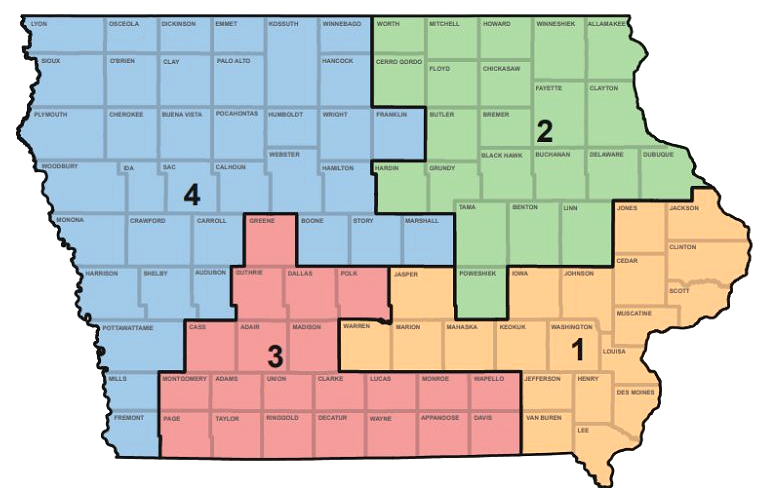By Jim Ellis
Nov. 10, 2021 — Gov. Kim Reynolds (R) signed the new Iowa redistricting map package, legislation that contained the new US House, state Senate, and state House of Representatives maps. The new congressional plan makes what appear to be minor changes to the state’s four districts, while again crafting a new quartet that would have voted in unison for former President Donald Trump. As is the case on the current map, Trump’s district victory margins featured varying percentages.
The Iowa redistricting system is unique. Some believe the state redistricts through a commission, but that is not the case. Rather, a state legislative committee is tasked with drawing the three-map plans and presenting them to the legislature for final approval. The plans must be submitted as a package, and the legislators may only vote up or down on the whole group, as no amendments to any of the maps are allowed.
The committee also employs a formulaic algorithm to create the districts without regard to political proclivities or deference to incumbents. If three map packages are rejected, the legislature then takes full control of the process.
The adopted package is the second plan iteration. The committee staff first put forth a series of maps that failed to make it through the first state Senate committee of jurisdiction. That congressional map was much different than the ultimately enacted plan. In the first draw, freshman Rep. Ashley Hinson (R-Marion/Cedar Rapids) would have been placed in a decidedly Democratic district that would have made her an underdog for re-election in 2022.
It is likely, however, that alone was not the reason for the Senate committee members rejecting the map package. The committee staff created two separate pairings of three incumbent senators apiece, thus dooming the entire package. Once returned, the congressional map plan, using a changed formula, returned to a similar configuration as under the current map.
The Iowa congressional map was not overly out of balance from a population context. The Des Moines-anchored 3rd District needed to shed 61,382 people. The western 4th District needed to gain 31,730 individuals, while the 1st and 2nd were required to add just under 20,000 residents apiece. Additionally, Iowa is one of the few states that received a waiver on balancing the districts to a factor of plus or minus one person. The largely homogeneous population and the equivalent area configuration of the state’s 99 counties allow all to remain whole within their assigned congressional district.
In the new plan, Districts 1, 2, and 3 all would have voted for former President Trump in percentages from 49.3 to 51.3 percent. The most Republican of these districts would be new District 2, which conforms to Rep. Hinson’s current District 1. The closest seat is again Rep. Cindy Axne’s (D-Des Moines) District 3 that would have broken 49.3 – 48.9 percent for Trump. This small margin is actually an improvement for Republicans from the current 3rd, which barely supported Trump over President Biden, 49.1 – 49.0 percent. The new 1st District, which most closely matches current District 2, would have supported Trump 50.5 – 47.6 percent.
This new District 1 (current District 2) is slightly downgraded from a 4.0 margin that Trump recorded in 2020. Rep. Mariannette Miller-Meeks (R-Ottumwa) won the current 2nd District by just six votes, so the 1.1 point partisan reduction could be significant. On the other hand, Rep. Miller-Meeks’ opponent, former state senator and 2018 lieutenant governor nominee Rita Hart (D), already has announced that she will not return to launch a congressional campaign in 2022.
As is currently the case, Iowa’s safest seat will be the western 4th District of freshman Rep. Randy Feenstra (R-Hull/Sioux City). The new 4th breaks similarly to that of the current 4th. Trump would have carried the new configuration with a 62.2 – 36.2 percent margin. It is this district that gives the Republicans their statewide advantage, which proves critically important in presidential, US Senate, and governor’s races.
The major story coming from the new map is that Reps. Miller-Meeks and Axne are technically paired in the 3rd District because the former woman’s home county, Wapello that houses her city of Ottumwa, is now part of District 3. The overwhelming majority of Rep. Miller-Meeks’ current constituency lands in new District 1, however, which is where she will undoubtedly seek re-election.
Rep. Axne, who has won her two congressional elections with less than majority support, also sees her district slightly downgraded from a partisan context. She has already endorsed former Rep. Abby Finkenauer (D) in her statewide race against Sen. Chuck Grassley (R), but has not closed the door on a gubernatorial bid against Reynolds. Now that the districts are drawn, we will soon see what decisions these office holders will make regarding their own political futures.

